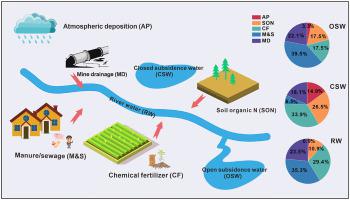Journal of Environmental Management ( IF 8.7 ) Pub Date : 2021-08-02 , DOI: 10.1016/j.jenvman.2021.113451 Jie Hu 1 , Xing Chen 1 , Yeyu Chen 1 , Chang Li 1 , Mengxi Ren 1 , Chunlu Jiang 1 , Yongchun Chen 2 , Shikai An 2 , Yanfei Xu 2 , Liugen Zheng 1

|
The increase in NO3− content in surface water caused by intensive mining activities in Huainan City, China, has attracted considerable attention owing to the deterioration of water quality and the degradation of ecosystems in recent years. The Huainan mining area, which is highly disturbed by anthropogenic activities, was selected as a typical observation area, and the surface water was classified as open subsidence water (OSW), closed subsidence water (CSW), and river water (RW). Moreover, the hydrochemical parameters and the δ15N and δ18O values of nitrate were employed to quantitatively trace the sources and biochemical transformation of NO3−, and the contribution ratios of different NO3− sources were estimated using the stable isotope analysis in R based on the Bayesian model. There was evident nitrification in the study area, but no significant denitrification has occurred. A substantial portion of δ15N–NO3- demonstrated complex sources of NO3−. Compared with those of CSW, the NO3− compositions of the OSW approached to those of the RW due to river recharge and discharge, and were greatly affected by anthropogenic activities. The proportional contribution of manure and sewage in the OSW was found to be the highest with a mean value of 39.5 % ± 12.3 %, which was followed by that of mine drainage (mean: 22.1 % ± 13.1 %), chemical fertilizer (mean: 17.5 % ± 10.6 %), and soil organic nitrogen (mean: 17.5 % ± 11.6 %). In the RW, the highest mean contribution of manure sewage was 35.2 % ± 9.7 %, which was followed by that of chemical fertilizer (mean: 29.3 % ± 7.2 %), mine drainage (mean: 23.4 % ± 13.0 %), and soil organic nitrogen (mean: 10.9 % ± 8.3 %). In contrast, the contribution of chemical fertilizer to the CSW was the highest with a mean value of 33.9 % ± 13.6 %, which was followed by that of soil organic nitrogen (mean: 26.5 % ± 13.8 %), mine drainage (mean: 18.1 % ± 11.6 %). Therefore, NO3− in the surface water of the mining area primarily originates from chemical fertilizers and manure sewage. In addition, the contribution of mine drainage to nitrate in the study area indicates the potential impact of mining activities on surface water. These findings highlight the value of classifying different types of surface water in tracing NO3− contamination sources, and provide relevant theoretical basis for tracing nitrate sources in other areas.

























 京公网安备 11010802027423号
京公网安备 11010802027423号